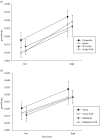Evolution of juvenile growth rates in female guppies (Poecilia reticulata): predator regime or resource level?
- PMID: 15705560
- PMCID: PMC1634969
- DOI: 10.1098/rspb.2004.2899
Evolution of juvenile growth rates in female guppies (Poecilia reticulata): predator regime or resource level?
Abstract
Recent theoretical and empirical work argues that growth rate can evolve and be optimized, rather than always being maximized. Chronically low resource availability is predicted to favour the evolution of slow growth, whereas attaining a size-refuge from mortality risk is predicted to favour the evolution of rapid growth. Guppies (Poecilia reticulata) evolve differences in behaviour, morphology and life-history traits in response to predation, thus demonstrating that predators are potent agents of selection. Predators in low-predation environments prey preferentially on small guppies, but those in high-predation environments appear to be non-selective. Because guppies can outgrow their main predator in low- but not high-predation localities, we predict that predation will select for higher growth rates in the low-predation environments.However, low-predation localities also tend to have lower productivity than high-predation localities, yield-ing the prediction that guppies from these sites should have slower growth rates. Here we compare the growth rates of the second laboratory-born generation of guppies from paired high- and low-predation localities from four different drainages. In two out of four comparisons, guppies from high-predation sites grew significantly faster than their low-predation counterparts. We also compare laboratory born descendants from a field introduction experiment and show that guppies introduced to a low-predation environment evolved slower growth rates after 13 years, although this was evident only at the high food level. The weight of the evidence suggests that resource availability plays a more important role than predation in shaping the evolution of growth rates.
Figures


Similar articles
-
LIFE-HISTORY EVOLUTION IN GUPPIES (POECILIA RETICULATA) 6. DIFFERENTIAL MORTALITY AS A MECHANISM FOR NATURAL SELECTION.Evolution. 1996 Aug;50(4):1651-1660. doi: 10.1111/j.1558-5646.1996.tb03937.x. Evolution. 1996. PMID: 28565709
-
Rapid evolution of escape ability in Trinidadian guppies (Poecilia reticulata).Evolution. 2002 Apr;56(4):776-84. doi: 10.1111/j.0014-3820.2002.tb01388.x. Evolution. 2002. PMID: 12038535
-
Local adaptation and the evolution of phenotypic plasticity in Trinidadian guppies (Poecilia reticulata).Evolution. 2012 Nov;66(11):3432-43. doi: 10.1111/j.1558-5646.2012.01694.x. Epub 2012 Jun 11. Evolution. 2012. PMID: 23106708
-
Life history evolution in guppies (Poecilia reticulata): guppies as a model for studying the evolutionary biology of aging.Exp Gerontol. 1997 May-Jun;32(3):245-58. doi: 10.1016/s0531-5565(96)00129-5. Exp Gerontol. 1997. PMID: 9193894 Review.
-
Experimental studies of evolution in guppies: a model for understanding the evolutionary consequences of predator removal in natural communities.Mol Ecol. 2008 Jan;17(1):97-107. doi: 10.1111/j.1365-294X.2007.03474.x. Epub 2008 Aug 23. Mol Ecol. 2008. PMID: 17725576 Review.
Cited by
-
Morphological divergence driven by predation environment within and between species of Brachyrhaphis fishes.PLoS One. 2014 Feb 26;9(2):e90274. doi: 10.1371/journal.pone.0090274. eCollection 2014. PLoS One. 2014. PMID: 24587309 Free PMC article.
-
Experimental translocations to low predation lead to non-parallel increases in relative brain size.Biol Lett. 2020 Jan;16(1):20190654. doi: 10.1098/rsbl.2019.0654. Epub 2020 Jan 22. Biol Lett. 2020. PMID: 31964256 Free PMC article.
-
Variable juvenile growth rates and offspring size: a response to anthropogenic shifts in prey size among populations.Oecologia. 2024 Oct;206(1-2):163-173. doi: 10.1007/s00442-024-05623-x. Epub 2024 Sep 20. Oecologia. 2024. PMID: 39302347
-
Are host-parasite interactions influenced by adaptation to predators? A test with guppies and Gyrodactylus in experimental stream channels.Oecologia. 2012 Sep;170(1):77-88. doi: 10.1007/s00442-012-2289-9. Epub 2012 Mar 9. Oecologia. 2012. PMID: 22402622
-
Population dynamics of thrips prey and their mite predators in a refuge.Oecologia. 2007 Jan;150(4):557-68. doi: 10.1007/s00442-006-0548-3. Epub 2006 Sep 9. Oecologia. 2007. PMID: 16964498
References
-
- Abrams P.A., Leimar O., Nylin S., Wiklund C. The effect of flexible growth rates on optimal sizes and development times in a seasonal environment. Am. Nat. 1996;147:381–395.
-
- Arendt J.D. Adaptive intrinsic growth rates: an integration across taxa. Q. Rev. Biol. 1997;72:149–177.
-
- Arendt J.D., Wilson D.S. Optimistic growth: competition and an ontogenetic niche-shift select for rapid growth in pumpkinseed sunfish (Lepomis gibbosus) Evolution. 1997;51:1946–1954. - PubMed
-
- Arendt J.D., Wilson D.S. Countergradient selection for rapid growth in pumpkinseed sunfish: disentangling ecological and evolutionary effects. Ecology. 1999;80:2793–2798.
-
- Ayres M.P., Scriber J.M. Local adaptation to regional climates in Papilio canadensis (Lepidoptera: Papilionidae) Ecol. Monogr. 1994;64:465–482.
Publication types
MeSH terms
LinkOut - more resources
Full Text Sources
Other Literature Sources

